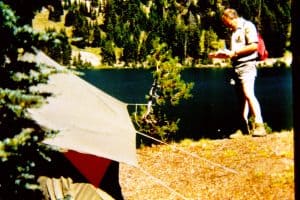
Les Joslin collecting campsite data in Three Sisters Wilderness.
By Les Joslin
My first summer in the Three Sisters Wilderness included several days locating and surveying campsites along the Pacific Crest National Scenic Trail, a dozen or so miles of which I accessed via bumpy old Road 600 that took me to the trailhead on the southwestern bank of Irish Lake. Despite that famous trail’s popularity, public contacts proved far and few between.
The only person I met on the Pacific Crest Trail one of those 1990 summer days made an immediate impression on me. Why? The first thing I noticed about him was the big pistol he packed on his hip. “Do you know where Dennis Lake is?” he asked. “My name is Dennis and I want to camp at Dennis Lake.” I got out my map and showed him how to get there. “Thanks,” he said. And that was that.
Another day that summer, I met a young couple camped along that stretch of the Pacific Crest Trail at Brahma Lake. I introduced myself and explained my purpose before I began to collect the data I needed at their campsite. “Do you know where Bristah Lake is?” the young woman asked.
“Yes,” I replied. “It’s along the trail about h
alf way between the Mirror Lakes Trailhead and the Mirror Lakes.” I’d already surveyed that area.
“Do you know how it got its name?”
“No, but I think I’m about to find out.”
“My name is Cheryl Bristah,” she continued. “”I have two sisters. My husband—my fiancé at the time—took me to a charity ball in Portland and made the winning bid on a prize offered by the publisher of the Three Sisters Wilderness map.” That was Geo-Graphics in Beaverton, Oregon. “The prize was naming that little lake.” Apparently her fiancé saw a certain symmetry in naming the little unnamed Three Sisters Wilderness lake for the three Bristah sisters, and did so on the next edition of the map.
Some years later I amazed a friend who served on the Oregon Geographic Names Board with that story. “They can’t do that!” he and, later, the whole board said, and so advised the map publisher.
A couple I met one September 1991 evening on the Pacific Crest Trail stretch between the Wickiup Plain and Sisters Mirror Lake—where I’d just finished my survey of the many camping sites around that lake and its several sister lakes—made my day when, after a brief discussion, they expressed appreciation at meeting a wilderness ranger on the trail. “We’ve hiked up here for years, and you’re the first ranger we’ve ever seen!” Just my presence, they said, assured them the Forest Service really cared and affirmed their faith in the government.
I felt good, even as I felt concern for the Forest Service’s minimal presence in this most visited unit of the National Wilderness Preservation System in Oregon noted for its scenic trails that included something over forty miles of the Pacific Crest Trail. A good encounter with a ranger should be part of a visitor’s wilderness experience, it seemed to me.
As it happened, my feeling for the land and the people kept me serving as a friendly face and a helping hand in the Three Sisters Wilderness—albeit in many ways I didn’t anticipate—for many summers to come even as it opened doors to other unexpected opportunities.